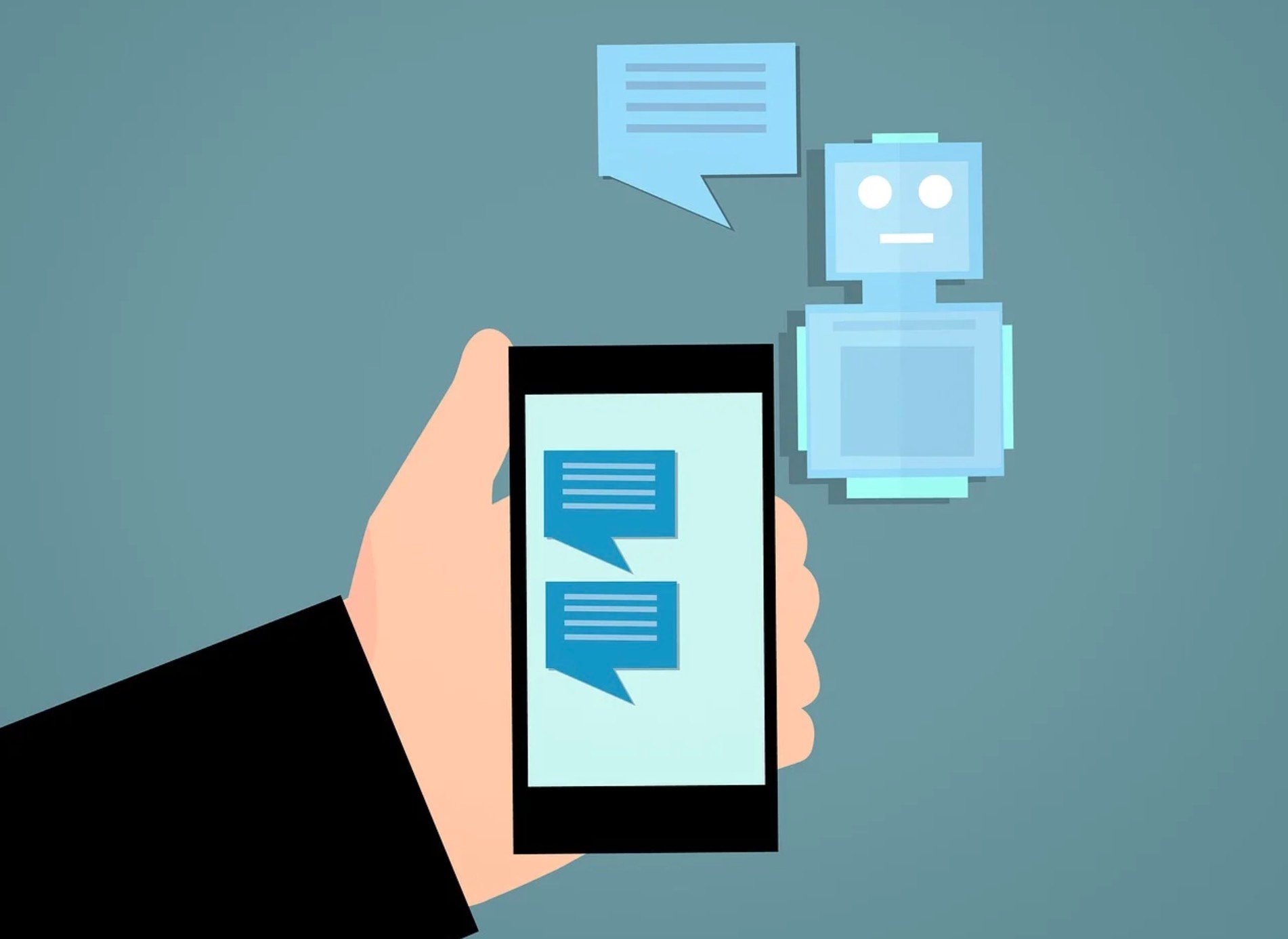We live in an era defined by instant communication and unparalleled convenience, the synergy between chatbots and text messaging has emerged as a transformative force in revolutionizing customer service within the directory website business.

Chatbots are computer programs that can simulate conversations with humans. They can be deployed on directory websites to answer customer questions, provide support, and even book appointments. And, text messaging is another convenient way for customers to communicate with businesses. It can be used to send notifications, reminders, and updates.
In this article, we will walk you through how chatbots and text messaging together enhance customer service efficiency in your directory website business. Plus, we will introduce a communication tool called HelpGent by wpWax to make your directory website more accessible. So, without further ado, let’s have a deep dive.
Understanding Chatbots
Chatbots are software applications or artificial intelligence (AI) systems that are designed to engage in conversations with users through text-based or voice-based interactions. They are programmed to understand and respond to natural language input, making them capable of simulating human-like conversations.
Chatbots can be rule-based, following predefined sets of instructions and responses, or they can be powered by AI and machine learning algorithms, allowing them to learn from interactions and adapt their responses based on the context of the conversation.
These virtual agents are used in a wide range of applications, including customer support, e-commerce, healthcare, finance, education, and entertainment, with the primary goals of improving user experiences, automating tasks, and providing assistance and information.
Text Messaging in Customer Service
Text messaging has become an increasingly popular and effective channel for customer service in recent years. It offers several advantages for both businesses and customers, including convenience, speed, and accessibility. Here are some key aspects to consider when using text messaging in customer service.
Instant communication
Text messaging enables real-time communication between businesses and customers, facilitating swift responses to inquiries and issues. This immediacy is highly valued in today’s fast-paced world.
Convenience for customers
Customers greatly appreciate the convenience of text messaging when dealing with straightforward inquiries, appointment reminders, or order updates. It eliminates the need to wait on hold during phone calls or constantly check email, making their lives easier.
Automation and chatbots
Implementing chatbots and automated responses can significantly enhance efficiency in handling routine queries. This technology allows businesses to allocate human agents to more complex issues, ensuring a more streamlined and responsive customer service process.
Personalization
Text messaging provides an opportunity to leverage customer data and purchase history to offer personalized recommendations and solutions. This personal touch enhances the overall customer experience and builds stronger relationships.
Feedback and surveys
Text messaging can be effectively used to collect valuable feedback and conduct customer satisfaction surveys. This information helps businesses make informed improvements to their products and services, aligning them more closely with customer preferences and needs.
How Chatbots Enhance Customer Service Efficiency
Chatbots can significantly enhance customer service efficiency in various ways, ultimately benefiting both businesses and customers. Here are some key ways in which chatbots improve customer service efficiency.
i. Automating routine tasks
Chatbots excel at handling repetitive and mundane tasks, such as password resets, account balance inquiries, or tracking orders. This automation frees up human agents to focus on more complex and value-added tasks.
ii. Responding to frequently asked questions (FAQs):
Chatbots are proficient at answering common customer queries by accessing a pre-defined knowledge base. This reduces the workload on support teams and ensures consistent and accurate responses 24/7.
iii. Processing orders and reservations
Chatbots can take orders, make reservations, and facilitate transactions efficiently, improving the speed and accuracy of the process while providing customers with a seamless experience.
iv. Assisting human agents
Chatbots can work in tandem with human agents, offering real-time suggestions, relevant information, and solutions. This collaboration enhances the productivity of human agents and ensures they have the necessary resources at their fingertips.
v. Routing inquiries to the right department
Chatbots can triage customer inquiries, directing them to the appropriate department or agent based on the nature of the request. This ensures that customers receive timely and accurate assistance.
vi. Providing context to agents
When a chatbot transfers a conversation to a human agent, it can provide a detailed history of the interaction, allowing the agent to pick up where the chatbot left off. This contextual information streamlines the conversation and improves the customer experience.
vii. Reducing response times
Chatbots can respond instantly to customer inquiries, eliminating the need for customers to wait in long queues or for agents to become available. This reduction in response times enhances customer satisfaction.
viii. Personalization through AI
Chatbots can analyze customer data and behavior to offer personalized recommendations, product suggestions, or tailored responses. This personal touch enhances customer engagement and loyalty.
ix. Tailoring responses to customer preferences
Chatbots can learn from past interactions and adapt their responses to align with a customer’s preferred communication style or language, improving the overall customer experience.
x. Using customer data effectively
Chatbots can access and analyze customer data to provide relevant information and insights during conversations. This data-driven approach enables chatbots to offer more informed and helpful responses.
Best Practices for Effective Chatbot and Text Messaging Use
Effective use of chatbots and text messaging requires careful planning and execution. Here are some best practices to ensure your chatbot and text messaging strategies are successful.
Define clear objectives
Before implementing a chatbot or text messaging system, it’s crucial to have a clear understanding of what you want to achieve. Are you looking to provide customer support, generate leads, or distribute information? Setting clear objectives will guide your strategy.
Understand your audience
To create a successful chatbot or text messaging system, you must know your target audience inside out. Understand their preferences, language, and communication style. Tailor your chatbot’s interactions to align with your audience’s expectations.
Design a user-friendly interface
A user-friendly interface is key to a positive user experience. Ensure that your chatbot or messaging system has an intuitive design that makes it easy for users to initiate conversations and navigate through interactions.
Leverage natural language processing (NLP)
Implementing Natural Language Processing technology is crucial for making conversations with your chatbot feel natural and human-like. NLP allows your chatbot to understand user queries and provide relevant responses effectively.
Provide value
Users are more likely to engage with your chatbot or text messaging system if they perceive it as valuable. Offer useful information, services, or solutions through your chatbot to keep users engaged and satisfied.
Maintain a consistent tone
Define a consistent tone and personality for your chatbot that aligns with your brand. Whether it’s friendly, professional, or humorous, maintaining consistency in tone helps create a cohesive user experience.
Offer real-time assistance
If your chatbot is designed for customer support, aim to provide real-time assistance. Quick responses to user queries can enhance customer satisfaction and resolve issues more effectively.
Integrate with existing systems
Ensure that your chatbot or text messaging system integrates seamlessly with your existing systems and databases. This allows for accurate and up-to-date information to be readily available to users.
Collect user feedback
Continuously collect feedback from users to improve your chatbot’s performance. Use this feedback to make necessary adjustments and refine your chatbot’s capabilities.
Monitor and analyze metrics
Keep a close eye on key performance metrics, such as user engagement, conversion rates, and user satisfaction. Regularly analyze these metrics to measure the effectiveness of your chatbot and identify areas for improvement.
Compliance and privacy
Ensure that your chatbot complies with relevant privacy regulations and guidelines. Respect user privacy and clearly communicate how their data will be used.
A/B testing
Experiment with different approaches, messaging styles, and features through A/B testing. This allows you to determine what resonates best with your audience and make data-driven improvements.
Challenges and Limitations of Chatbot and Text Messaging
Chatbots and text messaging have become increasingly popular communication tools in various industries, including customer support, healthcare, e-commerce, and more. However, they come with their own set of challenges and limitations.
Handling complex customer inquiries
Chatbots are often limited in their ability to handle complex and nuanced customer inquiries. While they excel at answering common questions and providing basic information, they may struggle with complex, multifaceted issues that require human judgment and expertise.
Maintaining a human touch in interactions
One of the key challenges in using chatbots is maintaining a human-like conversational tone and empathy. Customers may feel frustrated or disengaged if they perceive that the interaction is too robotic or lacks emotional understanding, especially when dealing with sensitive or emotional issues.
Dealing with language barriers and dialects
Chatbots may struggle to understand and respond accurately to diverse languages, dialects, accents, and colloquialisms. This can lead to miscommunication and frustration for users who speak languages or dialects that are less common or have variations.
Managing customer expectations
Setting accurate expectations for what a chatbot can and cannot do is crucial. Users may have unrealistic expectations about a chatbot’s capabilities, leading to dissatisfaction if the bot cannot fulfill their needs. It’s essential to manage user expectations and provide clear information about when human intervention may be necessary.
Limited context and memory
Chatbots often lack the ability to maintain context over long conversations or remember previous interactions with a user. This can result in repetitive questions and the need for users to provide the same information repeatedly, which can be frustrating.
Privacy and data security
Handling sensitive customer information through text messaging or chatbots can be a security concern. Ensuring that customer data is protected and compliant with data privacy regulations is essential to maintain trust.
Integration with legacy systems
Integrating chatbots into existing IT infrastructures and legacy systems can be challenging. Compatibility issues, data sharing, and system updates may be necessary to make chatbots work seamlessly within an organization.
Constant maintenance and updates
Chatbots require ongoing maintenance and updates to stay relevant and effective. As customer inquiries and preferences change over time, chatbot responses and capabilities must evolve accordingly.
Training and fine-tuning
Chatbots require substantial training and fine-tuning to improve their accuracy and effectiveness. This can be a time-consuming process that requires ongoing monitoring and adjustments.
Lack of creativity and problem-solving
Chatbots are rule-based and rely on pre-defined algorithms. They lack the creativity and problem-solving abilities that humans possess, making them less suitable for tasks that require innovation or complex decision-making.
Future Trends and Developments of Chatbot and Text Messaging
Chatbots and text messaging are rapidly evolving, and their future potential is vast. Here are some unique trends and developments to watch.
- Chatbots as AI companions: Chatbots are becoming more complex and entertaining, capable of holding discussions, offering emotional support, and even learning about specific users. This might pave the way for a new generation of AI companions to assist us with everything from managing our schedules to offering companionship.
- Chatbots for personalized education: Chatbots can help students of all ages receive individualized education. They can instruct students on certain topics, provide feedback on their work, and even assist them in developing critical thinking abilities. This has the potential to change the way we learn, making education more accessible and effective for all.
- Chatbots for mental health support: Chatbots can help persons in need of mental health support. They can listen to consumers’ problems, offer encouragement, and connect them with options for additional help. This could help to remove the stigma associated with mental health and make care more accessible to those who need it the most.
- Chatbots for social good: In a variety of ways, chatbots can be utilized to promote social good. They can, for example, be used to educate people about significant social issues, generate funds for charity causes, and even connect people with volunteer opportunities. One chatbot at a time, this might help make the world a better place.
- Text messaging for micropayments: Text messaging is becoming a popular channel for micropayments, thanks to the rise of mobile wallets and other payment platforms. This could make it easier for people to support their favorite creators and businesses, even with small amounts of money.
These are just a few examples of the many ways that chatbots and text messaging are being used to create a better future. As these technologies continue to develop, we can expect to see even more innovative and impactful applications.
How HelpGent Skyrockets The Growth of a Directory Business Website Powered by Directorist?
You’ve likely come across the renowned name Directorist, which is one of the top directory WordPress plugins available on the market. What’s intriguing is that Directorist also excels as one of the premier classified plugins, elevating classified websites to new heights.
And when you consider the incredible synergy between two WordPress plugins, HelpGent and Directorist, you’ll be amazed at the tremendous potential they unlock. Especially, HelpGent, an ultimate communication tool with exclusive features like asynchronous video, audio, and text messaging with a screen recording facility, and the conversational form will bring your directory business to an unprecedented landmark. Moreover, HelpGent comes with a dashboard where registered or even guest users can see their conversation and continue it.
Adding to that, some of the top-notch features of this ultimate communication tool include multi-screen form, a customizable screen with media like videos, a floating form like a chat bubble, a floating form customizer, email notification, 3 different layouts, a facility to save incomplete data, pre-made templates, cloud storage integration like Google Drive and Bunny integration.
Furthermore, the flawless integration of HelpGent with the robust Directorist directory plugin represents an exceptional collaboration. This partnership goes beyond merely enhancing the capabilities of both platforms; it orchestrates a harmonious and powerful user experience that seamlessly unifies their strengths.
Closing Remarks
The integration of chatbots and text messaging in directory website businesses represents a transformative leap forward in customer service efficiency. These intelligent digital assistants have not only revolutionized how businesses interact with their customers but have also elevated the overall user experience.
By providing instant, personalized, and 24/7 support, chatbots and text messaging ensure that customers’ needs are met promptly and efficiently. Moreover, the data collected through these interactions can be harnessed to refine services, identify trends, and make data-driven decisions, ultimately leading to improved offerings and increased customer satisfaction inside directory businesses.
Frequently Asked Questions (FAQs)
Q.1. How can text messaging enhance customer service on my directory website?
Text messaging allows you to engage with customers in real-time, and send updates, reminders, and notifications. It can enhance customer service by providing a convenient and immediate communication channel.
Q.2. Are chatbots and text messaging suitable for all types of directory websites?
Chatbots and text messaging can be beneficial for most directory websites, especially those with a substantial user base and frequent inquiries. However, their effectiveness may vary depending on your specific business model and target audience.
Q.3. What are the key features to look for in a chatbot for a directory website?
Look for features such as natural language processing (NLP) capabilities, integration with your website, customizable conversational flows, and analytics to track performance and user interactions.
Q.4. How can I integrate a chatbot into my directory website?
Integration methods vary depending on your platform and chatbot solution. Generally, it involves adding a chat widget or API integration to your website. Consult with your chatbot provider for specific integration instructions. Don’t be afraid you need web development skills.
Q.5. What types of tasks can a directory website chatbot handle?
Chatbots can handle tasks like answering frequently asked questions, assisting with search queries, providing business information, and even helping users submit listings or reviews.
Q.6. Can a chatbot replace human customer support entirely?
While chatbots can handle many routine tasks and inquiries, they may not replace human support entirely. Complex issues or personalized assistance may still require human intervention.
Q.7. How can I ensure that my chatbot provides accurate information to users?
Regularly update your chatbot’s knowledge base and train it with accurate data. Monitor its interactions and provide feedback to improve its performance over time.
Q.8. Are there any privacy concerns associated with using text messaging for customer service?
Yes, it’s important to handle user data securely and comply with privacy regulations such as GDPR or CCPA. Inform users about data usage and obtain consent for communication.
Q.9. How can I measure the success of my chatbot and text messaging initiatives?
Metrics to track may include response times, user satisfaction ratings, the number of resolved inquiries, and the impact on customer retention and conversion rates.
Q.10. What are the costs associated with implementing chatbots and text messaging in my directory website business?
Costs can vary based on the complexity of your setup, the chatbot solution you choose, and the volume of messages. Typically, there are subscription fees for chatbot services and potential messaging costs.
Author Bio:
| Syed Sazzadul Bari
A trailblazing CMO at SovWare, Sazzadul Bari marries creativity and data to shape compelling narratives that drive digital businesses forward. As the visionary behind BlogCD and WPFame, Sazzadul Bari empowers bloggers and WordPress enthusiasts, fostering connections that inspire growth. With digital marketing prowess, Sazzadul Bari is rewriting the playbook, propelling brands to new heights. |
Interesting Related Article: “Are Chatbots Profitable? (Using them With Email Marketing + Sales)“





